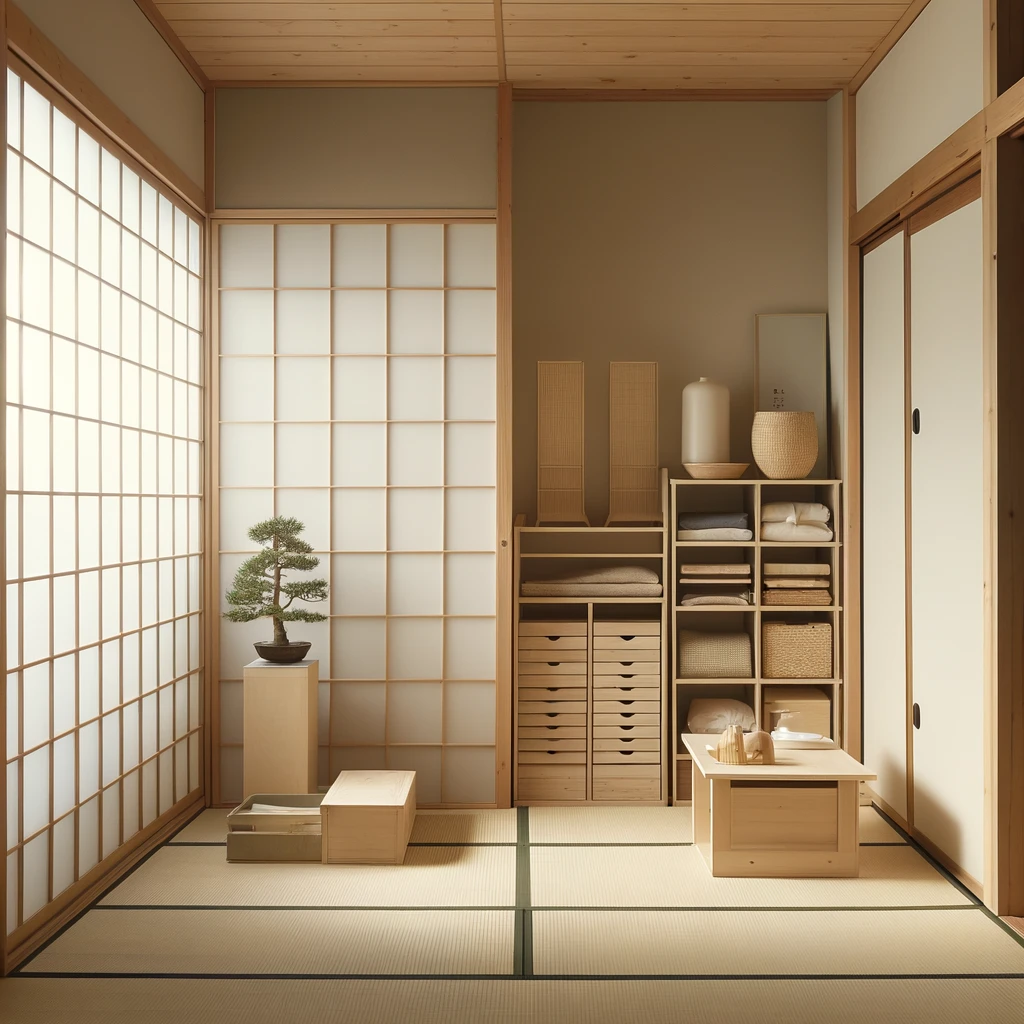Table of Contents
Introduction to Japanese Home Organization
Japanese home organization is rooted in a minimalist philosophy that emphasizes simplicity, functionality, and the beauty of essentialism. This approach is notably exemplified by Marie Kondo, a professional organizer whose methods encourage individuals to reevaluate their possessions and cultivate a meaningful environment. Her philosophy, known as the KonMari Method, encourages decluttering by focusing on what items “spark joy” for individuals, leading to a more intentional relationship with one’s belongings.
The act of decluttering is not merely about tidying up; it is a holistic process that can significantly enhance an individual’s emotional and psychological well-being. Research indicates that a well-organized space can reduce stress and promote clarity of thought. When one is surrounded by orderliness, it becomes easier to focus, leading to increased productivity and creativity. Furthermore, Japanese culture places a strong emphasis on harmony and balance, which can be achieved by minimizing clutter and fostering a serene living environment.
Embracing this minimalist lifestyle can transform one’s home into a sanctuary. Each item has its place and purpose, creating a sense of calm that invites relaxation and tranquility. A harmonious space can contribute not only to physical clarity but also to mental peace, allowing individuals to pursue their goals with greater determination. Consequently, the Japanese art of home organization transcends mere aesthetic appeal; it serves as a pathway toward a more fulfilling life, where distractions are minimized, and personal values can take precedence.
Understanding the KonMari Method
The KonMari Method, developed by Japanese tidying expert Marie Kondo, offers a unique approach to decluttering and organization. This methodology emphasizes the importance of tidying by category instead of by location, thereby allowing individuals to assess their belongings more holistically. The core principle of the KonMari Method is to focus on the emotional connection to items, encouraging one to keep only those that “spark joy.” This connection fosters a deeper understanding of what possessions hold value in one’s life, paving the way for a more intentional and fulfilling living environment.

The method consists of five key steps that serve as a guideline for those seeking to apply KonMari principles in their lives. The first step is to commit to tidying up. This involves making a firm decision to embark on the journey of decluttering, which can be both mentally and emotionally demanding. The second step encourages individuals to imagine their ideal lifestyle. By envisioning the desired outcome, one can create a clear motivation for the decluttering process.
Next, the third step involves finishing discarding first. This emphasizes the importance of sorting through belongings before organizing, ensuring that only cherished items remain. Following this is the fourth step, where tidying is done by category rather than by location. This method encourages a systematic approach to decluttering, allowing individuals to see the totality of their belongings in a specific category, such as clothing or books.
Finally, the fifth step is to follow the right order. The recommended sequence starts with clothing, followed by books, papers, miscellaneous items, and concludes with sentimental items. This structured approach helps individuals tackle less emotionally charged categories first, gradually building their confidence and decision-making skills in the later stages of tidying. Through these principles, the KonMari Method not only fosters a tidy space but also promotes a deeper emotional connection to possessions.
The Importance of Decluttering
Decluttering holds a significant position in Japanese culture, intertwined with values of minimalism, mindfulness, and intentional living. The concept transcends mere organization; it embodies a holistic approach to creating a tranquil environment that reflects harmony and simplicity. By reducing clutter, individuals can foster a sense of clarity that is vital for mental well-being. In this fast-paced world, where distractions abound, the act of decluttering becomes a form of meditation, allowing individuals to connect with their surroundings and themselves on a deeper level.
In Japan, the idea of ‘Mottainai,’ which emphasizes the importance of valuing resources and not wasting, resonates profoundly with decluttering practices. When individuals remove unnecessary items from their living spaces, they not only enhance functionality but also forge a commitment to sustainability. This process encourages the assessment of possessions, prompting an awareness of what truly adds value to one’s life. By doing so, people contribute to environmental preservation, reduce waste, and promote a more sustainable lifestyle. The act of letting go of items that no longer serve a purpose is a deliberate choice toward living more sustainably.
Furthermore, the benefits of a decluttered space extend beyond physical organization. A well-organized environment can lead to improved productivity, enhanced focus, and increased creativity. When physical space is optimized, individuals can streamline their daily activities, minimizing the mental load that often accompanies disorganization. This alignment with the Japanese ethos of mindfulness and simplicity underscores the profound impact that decluttering can have on overall quality of life. Embracing these principles allows individuals not only to transform their living spaces but also to cultivate a more purposeful existence.
Step-by-Step Decluttering Guide
The KonMari Method, developed by Marie Kondo, emphasizes tidying by category rather than by location. To begin your decluttering journey, follow this comprehensive step-by-step guide organized around five key categories: clothing, books, papers, komono (miscellaneous items), and sentimental items.
Start with clothing. Gather all your garments in one place, which allows you to see the full extent of your wardrobe. Handle each item individually and ask yourself if it sparks joy. If it does, keep it; if not, thank it for its service before letting it go. Store the remaining clothing neatly, possibly folding them vertically to maximize space and accessibility.
Next, move on to books. Collect all your books in a single location and evaluate each one. Consider whether you will reread the book or if it has any relevance to your life. If a book does not bring you joy or serve a purpose, carefully part with it. Create a space for those you choose to keep, ensuring that they are visually appealing and organized.
For papers, begin by sorting through all documents you have accumulated. This includes bills, receipts, and notes. Discard anything that is no longer needed, and categorize important papers into a designated filing system. Keep this organized to avoid future clutter and make accessing information easier.
When tackling komono, which encompasses miscellaneous items, categorize further into smaller groups such as kitchenware, electronics, or decorative items. This helps in systematically evaluating what adds value to your living space. For items that are broken or unused, consider disposing of them appropriately.
Lastly, approach sentimental items with care. This is often the most challenging category because it encompasses memories. Reflect on the emotions tied to each item and consider whether they genuinely enhance your life. If you choose to keep something, display it in a way that honors its significance.
Through this step-by-step method, you will effectively declutter your home, creating a welcoming and organized environment that supports your lifestyle.
Creating an Organized Home Setting
After the decluttering process, the next crucial step is establishing an organized home environment that promotes functionality and tranquility. One of the key aspects of achieving a harmonious living space is to create a designated place for every item. This practice not only simplifies finding items when needed but also encourages a consistent routine of returning items to their rightful locations.
When it comes to maximizing small spaces, innovative storage solutions can make a significant difference. Utilizing vertical space is a brilliant strategy; consider installing shelves that reach up to the ceiling or using tall storage units. These elements allow for the efficient use of wall space, freeing up floor areas and enhancing the overall organization of your home. Additionally, under-bed storage containers are an ideal option for stowing seasonal items or less frequently used belongings, thus keeping them out of sight yet easily accessible.
Another effective method is to incorporate multifunctional furniture, such as ottomans with hidden compartments or coffee tables with drawers. This approach not only helps to conceal clutter but also contributes to maintaining a minimalist aesthetic. When organizing items, consider categorizing them into visually cohesive groups, perhaps using decorative boxes or baskets that align with your home’s color scheme. This practice not only promotes order but also enhances the overall appearance of your space, creating a soothing environment.
Furthermore, embracing open shelving can encourage a curated display of cherished items, providing both accessibility and visual appeal. By thoughtfully arranging your belongings, you ensure that your space reflects your personality while remaining structured and tidy. Implementing these strategies will undoubtedly contribute to a peaceful home setting that inspires tranquility and comfort.
Incorporating Mindfulness and Intentionality
In the journey of decluttering, the principles of mindfulness and intentionality play a pivotal role. Practicing mindfulness encourages individuals to develop a conscious awareness of their surroundings, particularly their belongings. This practice not only enhances the decluttering experience but also fosters a deeper connection with possessions. Each item, whether it is a cherished souvenir or a functional tool, holds a specific value and meaning. By being present in the moment while evaluating these items, one can make more informed decisions about what to keep and what to let go.
Intentionality complements mindfulness by prompting individuals to examine the purpose behind owning each item. This can involve asking oneself whether an item sparks joy or serves a strategic function in daily life. The journey of decluttering becomes less about merely removing physical objects and more about cultivating a living space that reflects one’s values and aspirations. Such a thoughtful approach invites a sense of satisfaction and calm into the home, creating an environment conducive to personal well-being.
Additionally, paying attention to emotions and thoughts surrounding one’s belongings can unveil deeper insights. It is not uncommon for individuals to hold onto objects due to guilt or obligation rather than genuine joy or utility. A mindful decluttering process allows for the exploration of these feelings, helping to navigate the complexity of attachment. By prioritizing emotional awareness, individuals can disengage from items that no longer resonate with their current life narrative. This intentional practice promotes an atmosphere of clarity and purpose, ultimately leading to a space that nurtures growth.
In sum, integrating mindfulness and intentionality into the decluttering process can significantly enhance the effectiveness of home organization. Such practices encourage individuals to reflect on their belongings thoughtfully, fostering a more meaningful connection with their living space.
Maintaining Your Organized Space
Once you have successfully decluttered your home using the principles of Marie Kondo, the challenge of maintaining that sense of organization begins. To ensure that your living space remains tidy and clutter-free, incorporating regular routines is key. Establishing weekly or monthly routines can be incredibly beneficial. For instance, setting aside a specific day each week to tidy up can keep clutter at bay. Allocate just 15 to 30 minutes for each session; this makes the task manageable and less overwhelming.
Incorporating the ‘One In, One Out’ rule can also help maintain an organized environment. This practice involves committing to remove one item from your home for every new item that is brought in. For example, if you buy a new shirt, consider donating or discarding one of your old shirts. This rule fosters a mindful approach to acquisitions, emphasizing quality over quantity.
Moreover, periodically assessing your possessions is crucial for ongoing organization. Schedule monthly checks to review items in your home. During these assessments, ask yourself if each item serves a purpose, adds value, or brings you joy. If not, don’t hesitate to part ways with it. Maintain a designated place for items that you wish to donate, ensuring they are removed from your living space promptly.
Lastly, encouraging a culture of mindfulness within your household can reinforce these strategies. Engage family members in discussions about the importance of keeping shared spaces organized, which can promote collective responsibility. By integrating these strategies consistently, you can preserve the clarity and calm that comes from an organized home, allowing you to enjoy your space long after the initial decluttering.
Overcoming Challenges in Decluttering
Decluttering often presents emotional and practical hurdles that can hinder one’s ability to organize their space effectively. Many individuals grapple with attachment to items, a phenomenon that can create significant barriers during the decluttering process. It is common to feel a sense of nostalgia or sentimental value associated with belongings, making it difficult to part with them. To navigate these feelings, it is essential to assess the intentions behind keeping each item. One useful method is to ask oneself whether the object brings joy or serves a practical purpose in daily life. This approach aligns closely with the principles outlined by Marie Kondo, offering a guiding framework for decision-making.
Furthermore, the fear of letting go of possessions often stems from concerns about losing a piece of one’s identity or the anxiety surrounding future needs. It is helpful to reframe this fear by considering the space and mental clarity that will be gained through effectively decluttering. Visualizing the benefits of a more organized environment can diminish the emotional weight of the items in question. Setting realistic goals and timelines for the decluttering process can also alleviate pressure, encouraging individuals to take manageable steps rather than feeling overwhelmed by the task ahead.
Seeking support from friends, family, or professional organizers can also play a crucial role in overcoming these challenges. A second opinion can provide a fresh perspective, and having an accountability partner might motivate one to stick to their decluttering goals. Engaging with others can transform what may feel like a solitary and daunting process into a collaborative effort, fostering motivation and encouragement every step of the way. Ultimately, recognizing and addressing these emotional and practical challenges is integral to a successful decluttering journey.
Conclusion: The Benefits of a Simplified Life
Adopting Japanese home organization tips, particularly the KonMari Method, can significantly transform one’s life, providing numerous benefits that extend beyond a mere tidying process. This method emphasizes the importance of surrounding oneself with items that “spark joy,” allowing individuals to take a deep introspective as they declutter their spaces. With a focused approach to organizing, one learns to appreciate the value of their possessions and develop a deeper connection to their belongings.
A simplified life fosters enhanced mental clarity. By removing physical clutter, individuals often find that their thoughts become more organized as well. This mental decluttering can lead to increased productivity, enabling individuals to focus better on their personal and professional tasks. The act of tidying not only transforms physical spaces but also promotes a sense of peace and well-being. Consequently, many people report feeling less stressed and more in control of their environments.
Furthermore, incorporating these tips into daily routines can encourage individuals to maintain a more organized lifestyle long-term. The principles of the KonMari Method teach valuable lessons in mindfulness and intentionality about consumption and organization. As a result, individuals may develop habits that prevent clutter from accumulating in the first place, promoting a sustainable approach to maintaining an orderly home.

Embarking on a decluttering journey can facilitate personal growth, instilling a sense of accomplishment and pride in having an organized environment. As you reflect on the profound effects of a simplified and joyful space, consider the lasting changes that can integrate into all aspects of life. By embracing these Japanese home organization tips, one can not only cultivate a tailored living space but also enrich their overall quality of life dramatically.





